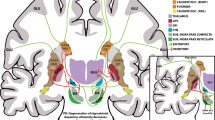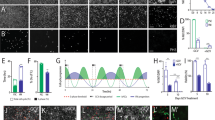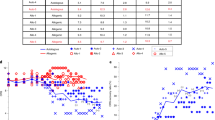Abstract
Transplantation of embryonic nigral tissue ameliorates functional deficiencies in Parkinson disease1,2. The main practical constraints of neural grafting are the shortage of human donor tissue and the poor survival of dopaminergic neurons grafted into patients, which is estimated at 5–10% (refs. 3,4 ). The required amount of human tissue could be considerably reduced if the neuronal survival was augmented. Studies in rats indicate that most implanted embryonic neurons die within 1 week of transplantation5,6, and that most of this cell death is apoptotic6. Modified peptides, such as acetyl–tyrosinyl–valyl–alanyl–aspartyl–chloro– methylketone (Ac–YVAD–cmk), that specifically inhibit proteases of the caspase family7 effectively block apoptosis in a plethora of experimental paradigms, such as growth factor withdrawal8, excitotoxicity9, axotomy10, cerebral ischemia11 and brain trauma12. Here we examined the effects of caspase inhibition by Ac–YVAD–cmk on cell death immediately after donor tissue preparation and on long–term graft survival. Treatment of the embryonic nigral cell suspension with Ac–YVAD–cmk mitigated DNA fragmentation and reduced apoptosis in transplants. It also increased survival of dopaminergic neurons grafted to hemiparkinsonian rats, and thereby substantially improved functional recovery.
This is a preview of subscription content, access via your institution
Access options
Subscribe to this journal
Receive 12 print issues and online access
$209.00 per year
only $17.42 per issue
Buy this article
- Purchase on Springer Link
- Instant access to full article PDF
Prices may be subject to local taxes which are calculated during checkout



Similar content being viewed by others
References
Lindvall, O. Neural transplantation: a hope for patients with Parkinson's disease. Neuroreport 8, III–X ( 1997).
Olanow, C.W., Kordower, J.H. & Freeman, T.B. Fetal nigral transplantation as a therapy for Parkinson's disease. Trends Neurosci. 19, 102– 109 (1996).
Kordower, J.H. et al. Functional fetal nigral grafts in a patient with Parkinson's disease: chemoanatomic, ultrastructural, and metabolic studies. J. Comp. Neurol. 24, 203–230 (1996).
Kordower J.H. et al. Fetal nigral grafts survive and mediate clinical benefit in a patient with Parkinson's disease. Mov. Disord. 13 , 383–393 (1998).
Barker, R.A., Dunnett, S.B., Faissner, A. & Fawcett, J.W. The time course of loss of dopaminergic neurons and the gliotic reaction surrounding grafts of embryonic mesencephalon to the striatum. Exp. Neurol. 141, 79–93 ( 1996).
Zawada, W.M. et al. Growth factors improve immediate survival of embryonic dopamine neurons after transplantation into rats. Brain Res. 786, 96–103 (1998).
Villa, P., Kaufmann, S.H. & Earnshaw, W.C. Caspases and caspase inhibitors. Trends Biochem. Sci. 22, 388–393 (1997).
Milligan, C.E. et al. Peptide inhibitors of the ICE protease family arrest programmed cell death of motoneurons in vivo and in vitro. Neuron 15, 385–393 ( 1995).
Leist, M. et al. Caspase–mediated apoptosis in neuronal excitotoxicity triggered by nitric oxide. Mol. Med. 3, 750– 764 (1997).
de Bilbao, F. & Dubois–Dauphin, M. Acute application of an interleukin–1 beta–converting enzyme–specific inhibitor delays axotomy–induced motoneurone death. Neuroreport 25, 3051–3054 (1996).
Hara, H. et al. Inhibition of interleukin 1beta converting enzyme family proteases reduces ischemic and excitotoxic neuronal damage. Proc. Natl. Acad. Sci. USA 94, 2007–2012 ( 1997).
Yakovlev, A.G. et al. Activation of CPP32–like caspases contributes to neuronal apoptosis and neurological dysfunction after traumatic brain injury. J. Neurosci. 17, 7415–7424 (1997).
Leist, M., Single, B., Castoldi, A.F., Kuhnle, S. & Nicotera, P. Intracellular adenosine triphosphate (ATP) concentration: a switch in the decision between apoptosis and necrosis. J. Exp. Med. 185, 1481– 1486 (1997).
Mahalik, T.J., Hahn, W.E., Clayton, G.H. & Owens, G.P. Programmed cell death in developing grafts of fetal substantia nigra. Exp. Neurol. 129, 27–36 (1994).
Nakao, N., Frodl, E.M., Duan, W.–M., Widner, H. & Brundin, P. Lazaroids improve the survival of grafted rat embryonic dopamine neurons. Proc. Natl. Acad. Sci. USA 91, 12408–12412 ( 1994).
Green, D. & Kroemer, G. The central executioners of apoptosis: caspases or mitochondria? Trends Cell Biol. 8, 267–271 (1998).
Leist, M. & Nicotera, P. Apoptosis, excitotoxicity, and neuropathology. Exp. Cell Res. 239, 183– 201 (1998).
Nakao, N. et al. Overexpressing Cu/Zn superoxide dismutase enhances survival of transplanted neurons in a rat model of Parkinson's disease. Nature Med. 1, 226–231 ( 1995).
Rosenblad, C., Martinez–Serrano, A. & Björklund, A. Glial cell line–derived neurotrophic factor increases survival, growth and function of intrastriatal fetal nigral dopaminergic grafts. Neuroscience 75, 979 –985 (1996).
Mayer, E., Fawcett, J.W. & Dunnett, S.B. Basic fibroblast growth factor promotes the survival of embryonic ventral mesencephalic dopaminergic neurons—II. Effects on nigral transplants in vivo. Neuroscience 56, 389–98 (1993).
Karlsson, J., Emgård, M., Rosenblad, C. & Brundin, P. Treatment with the spin–trap agent α–phenyl–N–tert–butyl nitrone does not enhance the survival of embryonic or adult dopamine neurons. Brain Res. 805, 155–168 (1998).
Whiteside, G., Cougnon, N., Hunt, S.P. & Munglani, R. An improved method for detection of apoptosis in tissue sections and cell culture, using the TUNEL technique combined with Hoechst stain. Brain Res. Brain Res. Protoc. 2, 160–164 ( 1998).
Duan, W.–M., Widner, H., Cameron, R.M. & Brundin, P. Quinolinic acid–induced inflammation in the striatum does not impair the survival of neural allografts in the rat. Eur. J. Neurosci . 10, 2595–2606 ( 1998).
West, M.J., Slomianka, L. & Gundersen, H.J. Unbiased stereological estimation of the total number of neurons in the subdivisions of the rat hippocampus using the optical fractionator. Anat. Rec. 231, 482–497 (1991).
Acknowledgements
We acknowledge the technical assistance of T. Björklund, B. Haraldsson, H. Naumann, B. Lindberg and M. Pettersson. This study was supported by grants from the Medical Faculty at Lund University, the Swedish Medical Research Council, the Thorsten and Elsa Segerfalk Foundation, and Deutsche Forschungsgemeinschaft. G.S.S. was supported by a Marie Curie Fellowship within the 4th framework program of the European Commission.
Author information
Authors and Affiliations
Corresponding author
Rights and permissions
About this article
Cite this article
Schierle, G., Hansson, O., Leist, M. et al. Caspase inhibition reduces apoptosis and increases survival of nigral transplants. Nat Med 5, 97–100 (1999). https://doi.org/10.1038/4785
Received:
Accepted:
Issue Date:
DOI: https://doi.org/10.1038/4785
This article is cited by
-
Co-transplantation of autologous Treg cells in a cell therapy for Parkinson’s disease
Nature (2023)
-
Histone deacetylase 2 regulates ULK1 mediated pyroptosis during acute liver failure by the K68 acetylation site
Cell Death & Disease (2021)
-
An adverse outcome pathway for parkinsonian motor deficits associated with mitochondrial complex I inhibition
Archives of Toxicology (2018)
-
Apoptosis Following Cortical Spreading Depression in Juvenile Rats
Molecular Neurobiology (2017)
-
The NLRP3 Inflammasome is Involved in the Pathogenesis of Parkinson’s Disease in Rats
Neurochemical Research (2017)



